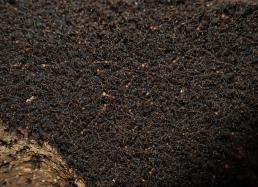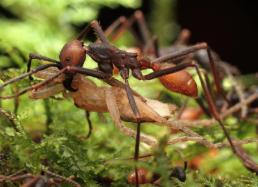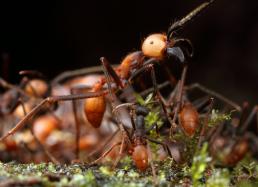Army Ants
Army ants have gotten a bad reputation, thanks to Hollywood. They're often pictured as ravenous predators that swarm the landscape, devouring every living animal in sight. But in reality, these efficient hunters target only other insects and are considered a keystone species for the critical role they play in many Neotropical rainforests, like those of Costa Rica.
More than 300 recorded species of birds, insects, reptiles, and other animals depend upon army ants for survival in some way. Understanding how these vitally important ants in turn depend upon bacteria to aid digestion and provide supplemental nutrition that rounds out an insect-based diet is one of the questions that Dr. Moreau's team is hoping to answer with their research.
An Evolutionary Advantage
In particular, the army ant species Eciton burchellii has evolved some unusual strategies for making the most of their food resources. While most army ant species have only three castes, Eciton burchellii has four. A soldier cast provides protection, while two smaller worker castes specialize in tending to the nest and bringing back typical army ant prey (social insects like other ant species, wasps, and bees).
The fourth caste, known as the "submajors," is unique to Eciton burchelllii and only one other species of army ant. Built like bulldozers, these superworkers come equipped with extra-long legs and huge jaws specially designed for capturing, cutting up, and carrying back spiders, katydids, and other insects far too large for all other army ant species to manage.
Nature or Nuture?
The question Dr. Moreau's team hopes to tackle is what triggered the evolution of such a distinct caste in the army ant world? Does the additional food supply available to Eciton burchellii trigger growth hormones that activate the development of a submajor (perhaps a genetic remnant of an ancestral giant)? Or is it that, unlike other army ant species that spend part of their lives underground, Eciton burchellii dwells entirely above ground, where body size is not limited by tunnel life?
Or, is this caste of superworkers a legacy left behind by specific fathers? Eciton burchellii queens mate with many more males than is typical for ants, so it may be that a father's genes help determine which caste an army ant will grow into as it matures. Further studies by Dr. Moreau's team will help resolve whether paternity or environment are more influential in the development of submajors.




